Abstract
Action potentials, initiated by brief depolarizing pulses, were recorded from single cells isolated from rat ventricular muscle. These action potentials showed a rapid upstroke to about +30 mV, followed by two phases of repolarization referred to as the early and late phases of the action potential. Nifedipine (1 microM), which blocks the second inward current (Isi) carried by Ca in these cells, shortened the early phase. Substitution of strontium for calcium in the solution bathing the cells, a procedure which prolongs Isi, prolonged the early phase. 4-Aminopyridine (1 mM), which inhibits transient outward current, prolonged the early phase with either calcium or strontium in the external solution. It is concluded that both Isi and transient outward current contribute to the early phase of the action potential in rat ventricular muscle. It is also suggested that Isi does not directly contribute to the late phase, since the characteristics of the late phase are not compatible with such a role, and the possibility of additional inward current is investigated in the accompanying paper (Mitchell et al., 1984).
Full text
PDF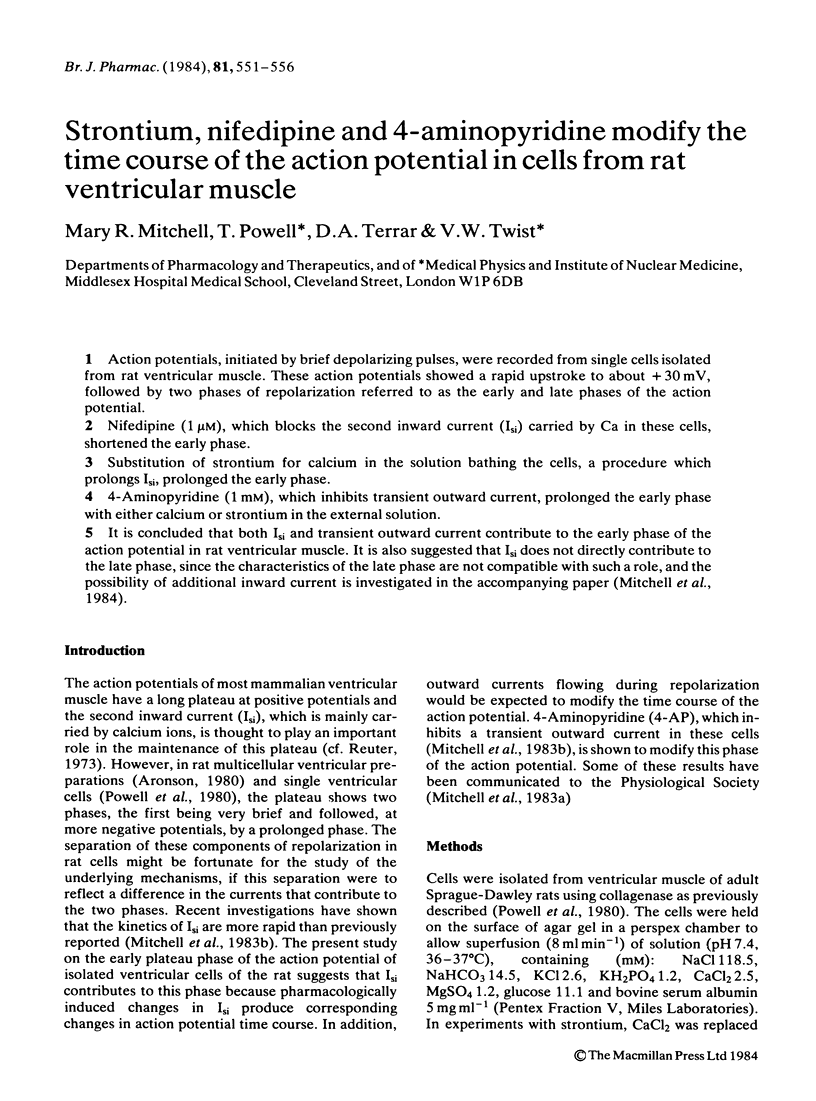
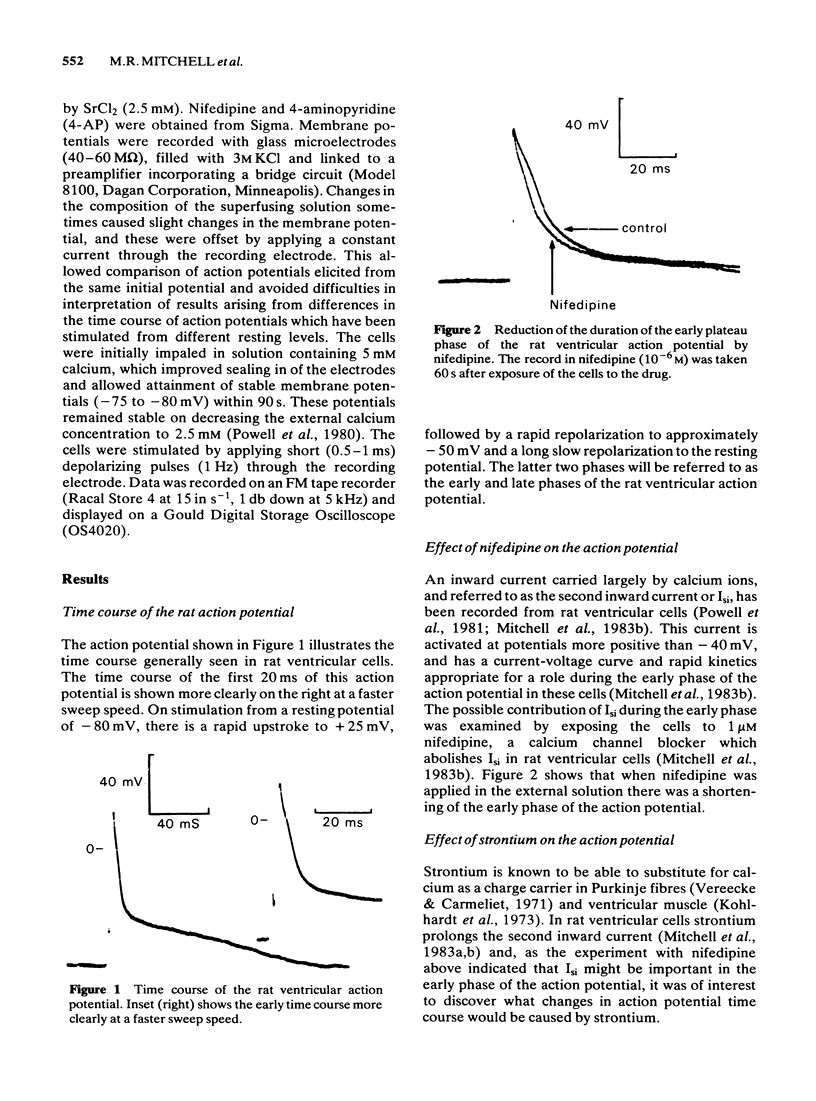
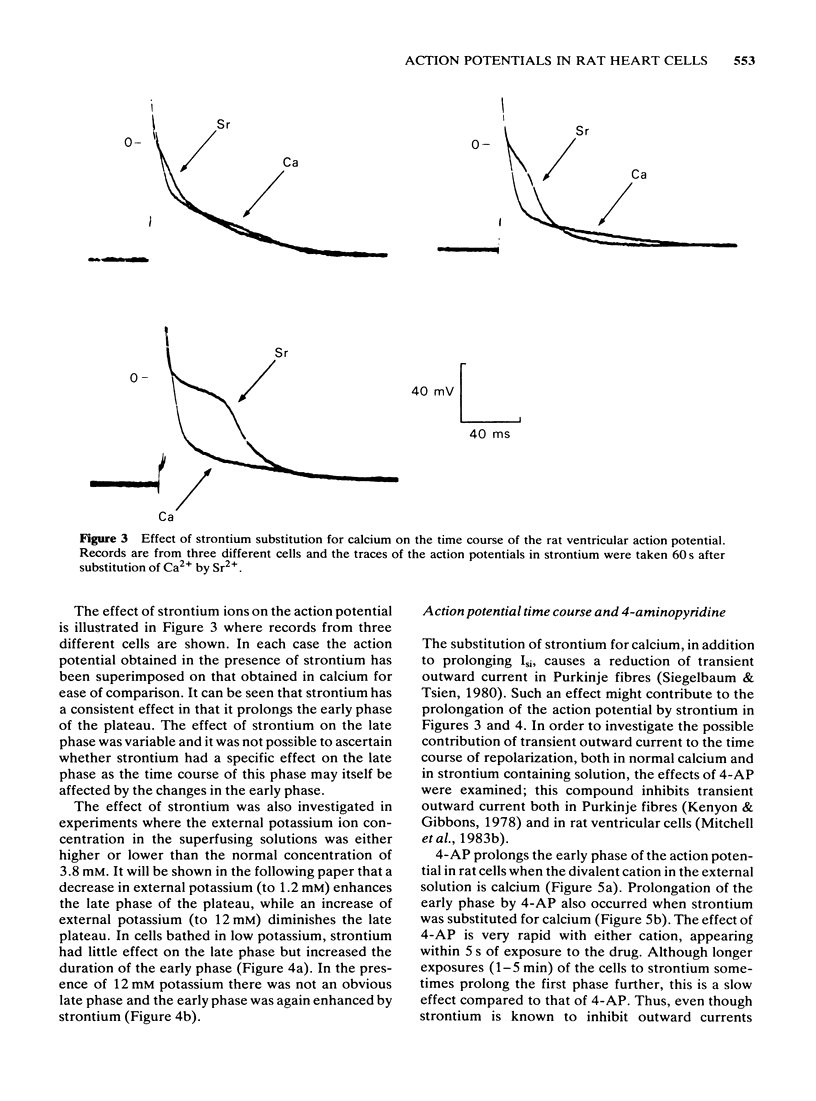
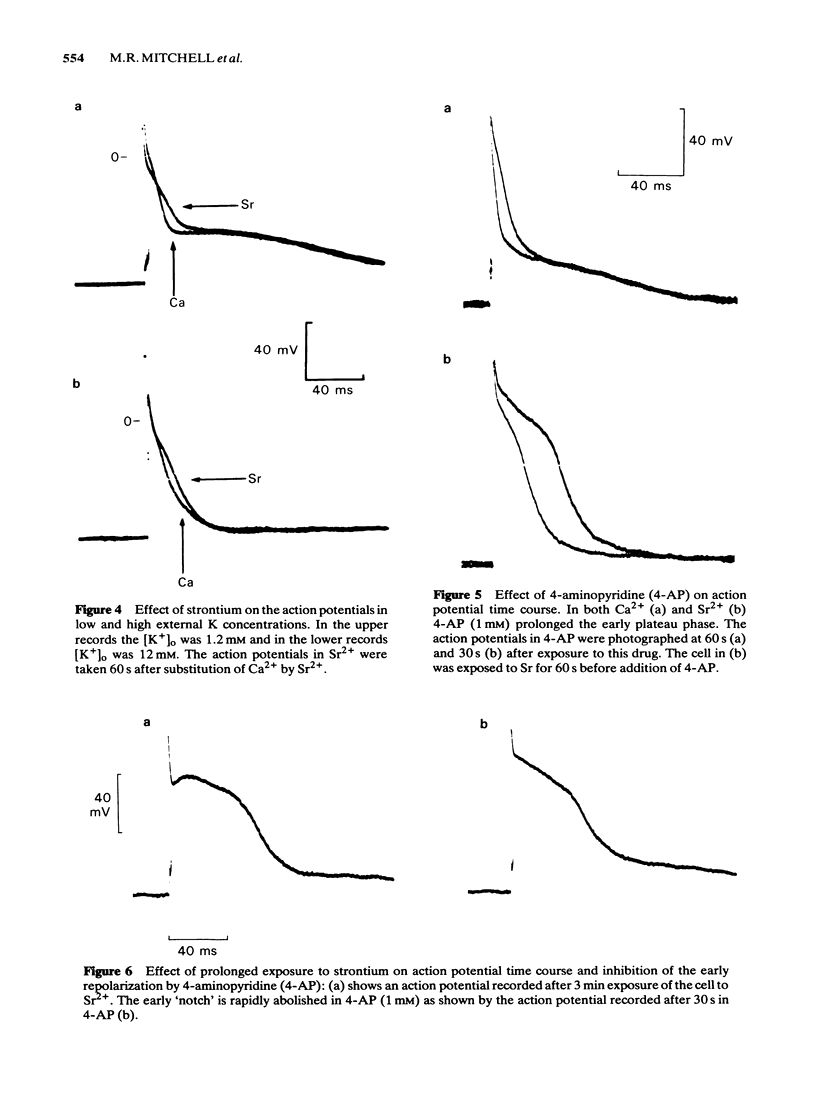
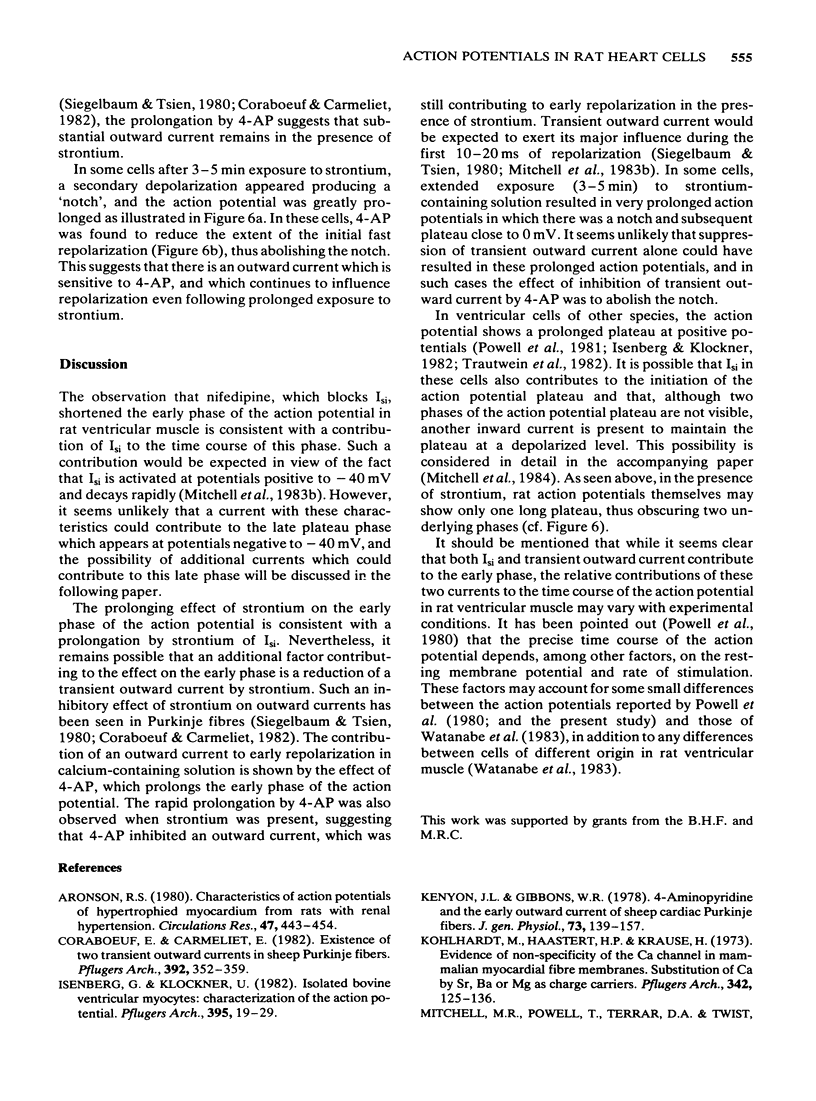
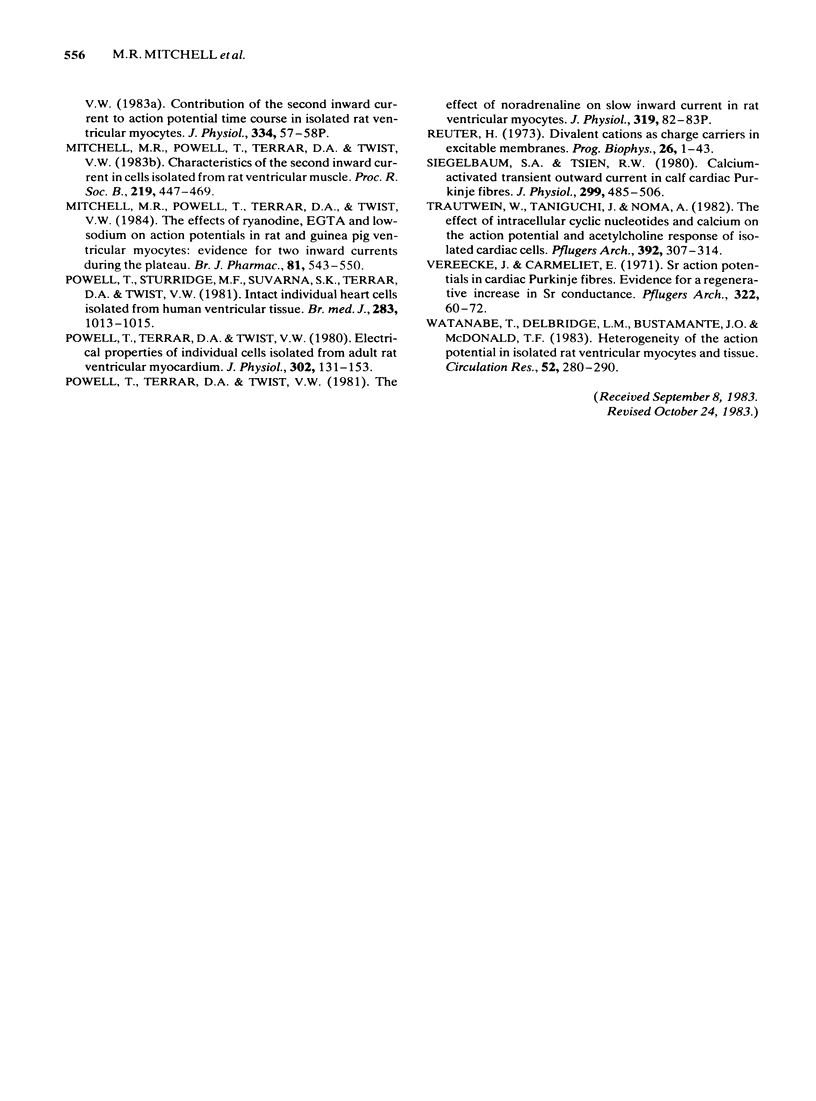
Selected References
These references are in PubMed. This may not be the complete list of references from this article.
- Aronson R. S. Characteristics of action potentials of hypertrophied myocardium from rats with renal hypertension. Circ Res. 1980 Sep;47(3):443–454. doi: 10.1161/01.res.47.3.443. [DOI] [PubMed] [Google Scholar]
- Coraboeuf E., Carmeliet E. Existence of two transient outward currents in sheep cardiac Purkinje fibers. Pflugers Arch. 1982 Feb;392(4):352–359. doi: 10.1007/BF00581631. [DOI] [PubMed] [Google Scholar]
- Isenberg G., Klöckner U. Isolated bovine ventricular myocytes. Characterization of the action potential. Pflugers Arch. 1982 Oct;395(1):19–29. doi: 10.1007/BF00584964. [DOI] [PubMed] [Google Scholar]
- Kenyon J. L., Gibbons W. R. 4-Aminopyridine and the early outward current of sheep cardiac Purkinje fibers. J Gen Physiol. 1979 Feb;73(2):139–157. doi: 10.1085/jgp.73.2.139. [DOI] [PMC free article] [PubMed] [Google Scholar]
- Kohlhardt M., Haastert H. P., Krause H. Evidence of non-specificity of the Ca channel in mammalian myocardial fibre membranes. Substitution of Ca by Sr, Ba or Mg as charge carriers. Pflugers Arch. 1973 Aug 17;342(2):125–136. doi: 10.1007/BF00587843. [DOI] [PubMed] [Google Scholar]
- Mitchell M. R., Powell T., Terrar D. A., Twist V. W. Characteristics of the second inward current in cells isolated from rat ventricular muscle. Proc R Soc Lond B Biol Sci. 1983 Oct 22;219(1217):447–469. doi: 10.1098/rspb.1983.0084. [DOI] [PubMed] [Google Scholar]
- Mitchell M. R., Powell T., Terrar D. A., Twist V. W. The effects of ryanodine, EGTA and low-sodium on action potentials in rat and guinea-pig ventricular myocytes: evidence for two inward currents during the plateau. Br J Pharmacol. 1984 Mar;81(3):543–550. doi: 10.1111/j.1476-5381.1984.tb10107.x. [DOI] [PMC free article] [PubMed] [Google Scholar]
- Powell T., Sturridge M. F., Suvarna S. K., Terrar D. A., Twist V. W. Intact individual heart cells isolated from human ventricular tissue. Br Med J (Clin Res Ed) 1981 Oct 17;283(6298):1013–1015. doi: 10.1136/bmj.283.6298.1013. [DOI] [PMC free article] [PubMed] [Google Scholar]
- Powell T., Terrar D. A., Twist V. W. Electrical properties of individual cells isolated from adult rat ventricular myocardium. J Physiol. 1980 May;302:131–153. doi: 10.1113/jphysiol.1980.sp013234. [DOI] [PMC free article] [PubMed] [Google Scholar]
- Reuter H. Divalent cations as charge carriers in excitable membranes. Prog Biophys Mol Biol. 1973;26:1–43. doi: 10.1016/0079-6107(73)90016-3. [DOI] [PubMed] [Google Scholar]
- Siegelbaum S. A., Tsien R. W. Calcium-activated transient outward current in calf cardiac Purkinje fibres. J Physiol. 1980 Feb;299:485–506. doi: 10.1113/jphysiol.1980.sp013138. [DOI] [PMC free article] [PubMed] [Google Scholar]
- Trautwein W., Taniguchi J., Noma A. The effect of intracellular cyclic nucleotides and calcium on the action potential and acetylcholine response of isolated cardiac cells. Pflugers Arch. 1982 Feb;392(4):307–314. doi: 10.1007/BF00581624. [DOI] [PubMed] [Google Scholar]
- Vereecke J., Carmeliet E. Sr action potentials in cardiac Purkyne fibres. I. Evidence for a regenerative increase in Sr conductance. Pflugers Arch. 1971;322(1):60–72. doi: 10.1007/BF00586665. [DOI] [PubMed] [Google Scholar]
- Watanabe T., Delbridge L. M., Bustamante J. O., McDonald T. F. Heterogeneity of the action potential in isolated rat ventricular myocytes and tissue. Circ Res. 1983 Mar;52(3):280–290. doi: 10.1161/01.res.52.3.280. [DOI] [PubMed] [Google Scholar]


